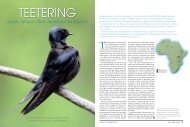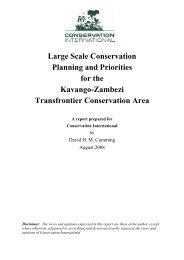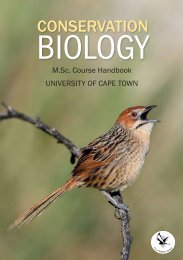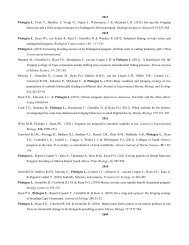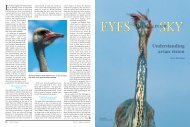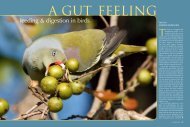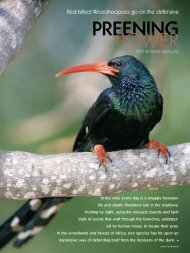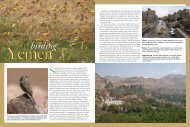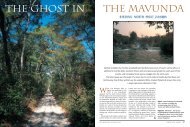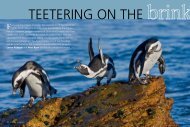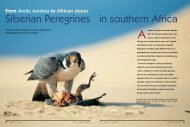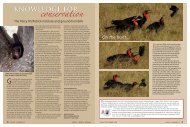Index of /depts/fitzpatrick/docs - Percy FitzPatrick Institute of African ...
Index of /depts/fitzpatrick/docs - Percy FitzPatrick Institute of African ...
Index of /depts/fitzpatrick/docs - Percy FitzPatrick Institute of African ...
Create successful ePaper yourself
Turn your PDF publications into a flip-book with our unique Google optimized e-Paper software.
<strong>of</strong> different farming methods in the sourveld grasslands <strong>of</strong>KwaZulu-Natal, the valley thicket <strong>of</strong> the Eastern Cape, theNama Karoo and the Bokkeveld Plateau aroundNieuwoudtville in the Northern Cape. The week-longworkshops were attended by a wide range <strong>of</strong> ecologistsand resource economists that had been working in theseareas.• We found that the notion <strong>of</strong> “conservation farming” differsconsiderably from area to area, depending on theecosystem characteristics and types <strong>of</strong> threats tobiodiversity. This also meant that different analyticalapproaches were required for different areas.• In some areas, such as Eastern Cape Thicket,conservation friendly farming is also more lucrative, andthe conversion to conservation farming is selfperpetuating.In other areas, such as in KZN grasslands,conversion to other land uses is far more lucrative, andonly tight regulation will prevent unacceptably high losses<strong>of</strong> biodiversity. Protected areas are optimal in areas whereendemism is extremely localised, such as on theBokkeveld Plateau. In areas where the ecologicalimplications <strong>of</strong> alternative farming methods cannot easilybe discerned (e.g. the Nama Karoo), economic analysis ismore difficult. This research is still ongoing.StudentsHilary Anderson (MSc, co-supervised by Theunis de Wet andPaul Fatti, University <strong>of</strong> Pretoria, graduated June 2003); Aneconometric analysis <strong>of</strong> the wildlife market in South AfricaRuth Parker (MSc, co-supervised by Mark Botha, BotanicalSociety <strong>of</strong> South Africa); Incentives for conservation <strong>of</strong>Renosterveld on private farmlandWater Resources and Estuarine ConservationA strategy was developed for conserving South Africa’s estuaries.Photo: Barry ClarkOverviewThis programme aims to improve decision making regardingthe allocation <strong>of</strong> water resources and the management andconservation <strong>of</strong> estuarine and other aquatic habitats. Researchprojects initiated, ongoing or completed during the reviewperiod included the development <strong>of</strong> a strategy for theconservation <strong>of</strong> estuarine biodiversity, and a set <strong>of</strong> researchprojects designed to improve our understanding <strong>of</strong> estuarinebiodiversity with a view to improving existing importancerankings.David Knox had apparently sieved one too many samples <strong>of</strong> stickymud in the Keiskamma estuary. Photo: Barry ClarkHighlights• A report <strong>of</strong> a complete count <strong>of</strong> the birds <strong>of</strong> the formerTranskei Coast (counted Feb 2002) was compiled.• Existing data on invertebrates and birds <strong>of</strong> Cape estuarieswere collated in a database.• A comprehensive study <strong>of</strong> intertidal invertebrate fauna wascarried out on 16 warm temperate estuaries.• A review <strong>of</strong> current estuarine protection mechanisms andon-the-ground effort, as well as a review <strong>of</strong> the presenthealth <strong>of</strong> South <strong>African</strong> estuaries suggested that ourestuaries are not well protected but have been fairlyresilient to past disturbances.• An analysis <strong>of</strong> threats to South <strong>African</strong> estuarieshighlighted the proximate and ultimate causes <strong>of</strong> estuarinebiodiversity loss, and suggests that threats are increasingto unprecedented levels.• In light <strong>of</strong> the above, a strategy was developed forestuarine biodiversity protection, the main components <strong>of</strong>which include research and knowledge management,regulation and enforcement, the creation <strong>of</strong> conditions andincentives that support estuary protection, monitoring andadaptive management and rehabilitation.StudentsDavid Knox (MSc, graduated June 2003, co-supervised byBarry Clark); Assessing the conservation importance <strong>of</strong>estuarine intertidal invertebrate communities: a pilot study <strong>of</strong>warm temperate estuaries in South Africa.26 <strong>Percy</strong> <strong>FitzPatrick</strong> <strong>Institute</strong> Annual Report: July 2002 - June 2003



